Spring 2023
Celebrating 73 years of connecting people to the land

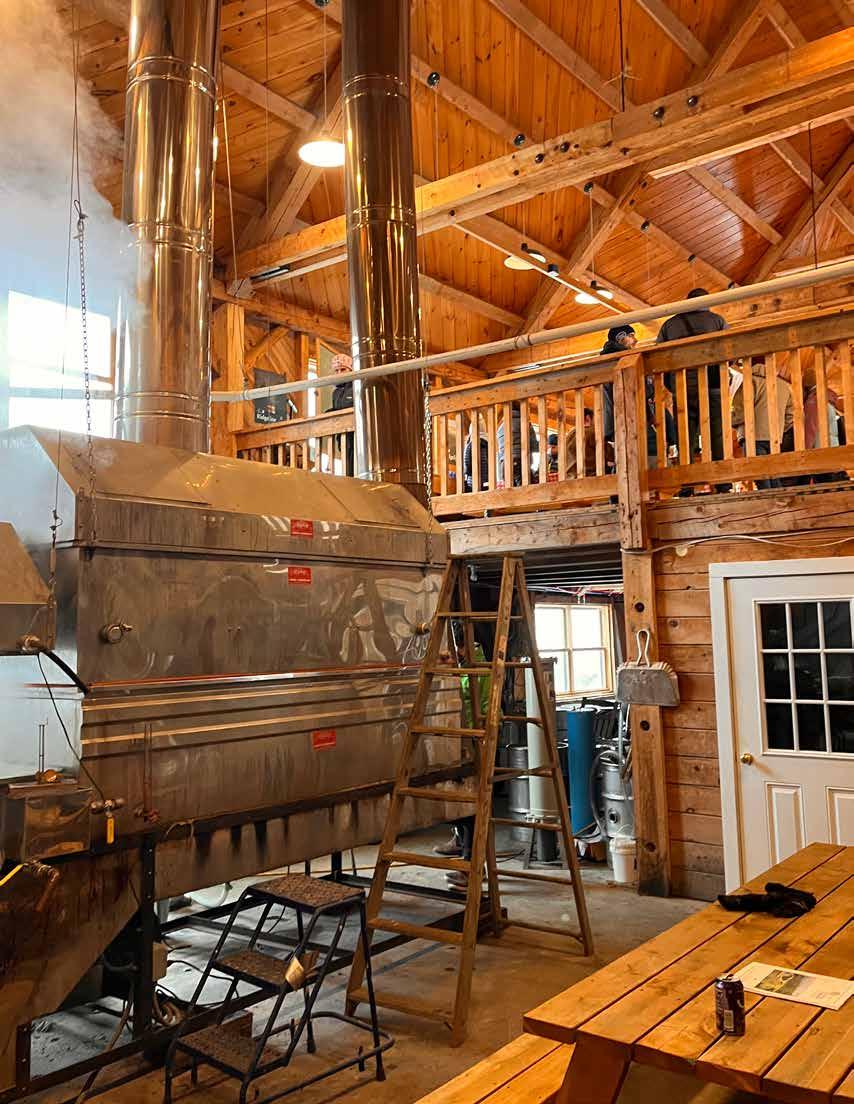
MFFC BOARD OF TRUSTEES
Jill Perry Balzano
Merrill Bent

Dinah Buechner-Vischer
Jim Hand
Peter Hicks
Greg Hopper, Treasurer
Karen Kellogg
Mark Lourie
John Stasny, Vice President & Secretary
Sue Van Hook, President
Brian Vargo
ADVISORS
Chris Brooks
Donald Campbell
Jean Ceglowski
Austin Chinn
Michael Fernandez
George Hatch
Jock Irons
Jon Mathewson
Sam Schneski
STAFF
Stephanie Breed, VC Coordinator
Cara Davenport, Education Manager
Dylan Durkee, Fleet & Facilities Manager
Chris Ferris-Hubbard, Education Director
Marybeth Leu, Business & Systems Manager
Amy Pim-Capman, Advancement Coordinator
Liz Ruffa, Advancement Director
Elena Santos, Education Coordinator
Hadley Stock , Farm Manager
Mike Stock, Resource Management Coordinator
Rob Terry, Executive Director
2
GRAPHIC & PHOTO CREDITS: Cara Davenport: p. 6, 7, 8, 9, 11 • Kathryn Lawrence: p. 16 MFFC Archive: p. 12, 13 • Amy Pim-Capman: p. 7 • Liz Ruffa: p. 4, 14, 15 Elena Santos: p. 7, 16 • Hadley Stock: front cover, p. 2, 3, 5, 6, 7, 8, 10, 14, 15, 17 and back cover • Anna Terry: p. 5 Content: MFFC Advancement Office • Magazine layout: Peppergrass Design Studio
Director’s Note: Spring 2023
By Rob Terry, Executive Director
Several weeks ago, with a late winter nor’easter poised to bury southwestern Vermont, talk in the Visitor Center turned to the relationship between the calendar and the value of snow. On the front end of the season, in late October and early November, the snow can’t come soon enough or fall deep enough. The snowy season starts in mid-November in our minds, but often not until late-December in the mountains. Come March, Vermont’s snowiest month, the storms that motivated outdoor enthusiasts from around the region to pack up their gear and head to the mountains find many of those same folks shopping for new board shorts on-line while dreaming of trips to the beach.

It’s easy to write off March and April in Vermont as nothing but cold rain, mud, gray skies and fierce winds— something to be escaped rather than enjoyed. While it’s easy to feel the pull of tropical latitudes this time of year, it would be a shame to miss out on all that spring in the north woods has to offer. A veritable symphony builds over time as a host of birds return for the season and scores of amphibians emerge from underneath the leaf litter and return to ponds and vernal pools. Sap flows and steam bellows out of sugar houses. Small streams that will be dry by July fill with cascading snowmelt that lends a fleeting beauty to the woods while enriching the spring soundscape. Ephemerals take advantage of the brief window in which the sun has returned, but the canopy has not leafed out, to carpet the forest floor with their vibrant, delicate flowers. It truly is a time of renewal.
Go out into the woods and celebrate the small things. Listen to the spring peepers chirp and the red wing blackbirds sing. Search for egg masses in vernal pools. Seek out the trout lily, spring beauties, bloodroot and Dutchman’s breeches. Toss a stick into a spring creek seething with snowmelt and watch it tumble through the rapids. It’s easy to overlook the forest this time of year, to write these months off as a dormant shoulder season. In reality, it is a time of reawakening and rejuvenation that rewards patience and a keen eye with a sense of hope and excitement—don’t miss out.
Welcome from the Board President
By Sue Van Hook, Board President

There is something special about beginning a tradition. As the years pass, the connection to it deepens. I first started coming to a Merck Forest cabin in 2002 on December 22nd. It was the perfect transition from grading papers at the end of the fall semester and giving myself a few days to recharge before Christmas Day. My oldest daughter and two of her friends joined me and a colleague at Ned’s Place. There was abundant snow that year and these high school seniors had fun building snow creatures in the moonlight. My friend and I stuck to playing cribbage inside. For many more years I kept to these dates - hike in on December 22nd and hike out on December 24th. Most mornings on Christmas eve, snug in a sleeping bag reading a good book, I asked my daughter if we could just stay put. As a college student just beginning break, she was always in agreement -” It is so peaceful, Mom.” But we always made our way down the mountain and home in time to make the stollen, another long held family tradition. On our way out we always stopped at the Visitor Center to book a cabin for the following year, same dates.
But why am I speaking of December when spring is upon us? It is to remind myself of the importance of appreciating those things that remain a constant and embracing the newness of change. Up on the mountain this winter at MFFC, we experienced an early snowfall, a long hiatus from any snow, and a few whopper blizzards late in the season. The reliable snows of Decembers past are no longer a sure thing. It seems it’s time to start new traditions. There are many of you who include time spent at MFFC in your tradition making. We’d love for you to tell us about them and how they have changed from then to until now.
Things to do in the Spring at MFFC
Compiled by Elena Santos, Education Coordinator
• Hike to Page Pond to sit and watch the water. What is happening there?
• Look for early spring ephemerals that are blooming: trout lilies, dutchman’s breeches, violets, jack-in-the-pulpit, and red trilliums
• Get involved in citizen science and document your findings with iNaturalist
• Pick some forsythia branches; bring them inside, force them in water to bloom
• Go for a hike and pay close attention to the trees and forest as you go…what do you notice? See the newly unfurled leaves?
• Start a nature journal! Keep track of dates when flowers and wildlife start to appear
• Sit quietly in the woods, or in a field, and listen to the world waking up
• Take up bird watching. All you need to get started is curiosity (binoculars and a field guide will help too)
• Pull some invasive garlic mustard and make pesto from it (early and young shoots only)
• Hike the MFFC Farm Trail: can you find places where red squirrels have sat and eaten the seeds from pine cones?
• Go foraging for ramps or fiddleheads- be sure to collect responsibly! (take half or less than half from each plant)
• Watch for “bud-out” on different species of trees…what do you notice?
• Lay on the ground and look at the world from a bug’s eye view
• Stomp in a mud puddle, or make mud pies!
• Download the Merlin Bird ID app from Cornell Lab of Ornithology and use it to identify bird calls
• Fly a kite, make a pinwheel
• Collect fallen leaves, sticks, pinecones, and other objects on the ground to make art on the forest floor

• Watch the greening trees creep up the mountainsides
• Keep your eyes open for yellow coltsfoot flowers
• Listen for nighttime peepers and wood frogs
• Try some maple syrup in a new recipe
• Walk by the Children’s Garden every few weeks and watch as it wakes up and grows
• Come up to visit our newborn lambs, chicks, and piglets, expected from April through May!
4

5
What’s Happening up on the Mountain
Compiled by Liz Ruffa, Advancement Director
Stephanie Breed and Marybeth Leu, Visitor Center & Systems Manager
Exciting news! Marybeth and I have been diligent in our quest to streamline various software systems. We are proud to announce that MFFC is striving to go paperless whenever possible. One big change is our credit card processor. We now offer touchless and receipt-less transactions. Another fun change - our reservation system is now integrated into our website. These changes may not seem that exciting to you, but they are significantly important to us. Going paperless and saving trees is always exciting!
Cara Davenport, Education Manager
Spring here (and maybe everywhere) always seems like more of a transition than a definitive season, this inbetween hard-to-quantify space where energy stores are being pushed into new growth and activity, where planning becomes action. Merck Forest is an active place no matter the season but we are definitely moving into the busier field season in our programs and event calendar. While sugaringfocused field trips and programs are beginning to taper off, I’m looking forward to plenty of other farm and forest programs. Camp registration is currently in open enrollment, the farm is brimming with new life, and the woods are full of buds. I’m especially excited for our upcoming Spring Break Camp, and to engage with students and teachers who participate in our spring 6th grade field trip series.
Dylan Durkee, Fleet and Facilities Manager
Logging classes will be here before we know it, as will the SOLO Wilderness First Aid course. I’ve been doing some partner work, and, in collaboration with Southern Vermont Art Center, we now have a series of photography classes lined up, starting in May. I’ve also been digging into and learning about wetlands as I begin work on projects involving our Mettawee Community School - adjacent campus in Pawlet.
Amy Pim-Capman, Advancement and Visitor Experience Coordinator
In other news, some may notice that Ellie the Cat is partially shaved on both sides. She is a Maine Coon and needs constant brushing to prevent her fur from matting. When her mats became quite severe this winter, current advisor, former trustee and longtime friend Dr. Jean Cegloski (a retired veterinarian in Rupert) offered to help. Ellie was quite stoic, for a bit. We will continue to remove the mats and hope to make her feel more comfortable.

Come visit - Merck Forest is beautiful this time of year.


I am finishing up the timber shop. What is left to be done on the buildingsiding, window installation, overhead doors, electrical, heat and installing a metal roof. So, there’s plenty to do and great weather coming up to do it in. I am also milling wood for upcoming projects here at Merck Forest.
Chris Hubbard, Education Director
While there is still some snow on the ground, spring is definitely in the airdaffodil buds are swelling and crocus leaves are emerging from the ground. With Maple Open House behind us and our maple sugaring programs subsiding, focus now turns to spring programming. Spring and summer camps are filling up. The Game of
As winter unravels and spring begins to sing on the mountain, I am increasingly grateful that Merck Forest and Farmland Center is my work destination 4 days a week. I share my time between the Advancement Office and the Visitor Center, managing membership and annual fund programs, assisting with institutional promotion and outreach and building partnerships with local businesses. Connecting with individuals and families while at the Visitor Center front desk is gratifying and helpful to my Advancement work. I have enjoyed assisting with educational programs this winter and look forward once again to being a 2023 Summer Camp field educator.
6
LIz Ruffa, Advancement Director
2023 has gotten off to a great start in the Advancement Office. After closing a very successful 2022 Annual Fund, Advancement is now diversifying MFFC’s membership program through two categories set to launch this spring and summer - corporate memberships and junior memberships. Stay tuned! Advancement is also conducting an operational assessment and business study of the Northshire Grown: Direct CSA model that MFFC spearheaded during Covid. In June, MFFC will host a networking event at the Sap House for members of the Southwestern Vermont Chamber of Commerce.
garden plan for the growing season in the Children’s Garden, grow seedlings and eat garden fresh veggies, build raised beds and cold frames, play games and conduct experiments, and maintain the perennial flower beds around the Visitor Center. Four Winds with Mettawee Community School classes have been a blast this year - I have run lessons on owls, defenses, predators and prey, and skulls with the Kindergarteners, fourth and fifth graders. Lessons will continue through the end of the school year.
Hadley Stock, Farm Manager

excitement with them. We just wrapped up our first Maple Ambassadors group with LTS. It’s such a fulfilling opportunity to work with these wonderful students who show up excited to learn and lend a hand. Spring is both an exhausting and thrilling time of year for me. There is so much new life popping up all around, I’m excited to share it with all of our visitors.
Elena Santos, Education Coordinator
The end of January marked my first year working at Merck Forest. The Kits and Cubs program is growing, running twice a week on Mondays and Wednesdays from 10-11:30am. A small number of families have become weekly regulars and we are always meeting and welcoming new families. As the weather warms up we look forward to time spent in the Children’s Garden, around Page Pond and meeting the baby animals that will soon be born! Kits and Cubs will transition to summer hours beginning July 10 and run from 1:30–3pm. I’m excited to be working with Long Trail School students who have signed up for a Garden Club E-Class this spring. The students and I will work together to make a

Spring is a busy time of year on the farm. If I’m not in the sugar house with Mike making maple syrup, I’m probably in the barn checking the ewes for signs of lambing. When ewe checks are done, I can be found pruning the blueberries or apple trees or checking for leaks in the sugarbush. Then there are the horses who love rolling in the grass and mud this time of year and need to be brushed. I’m planning for the grazing season, figuring out who will go where, when and for how long. I am preparing for new chicks, both hatching in our incubator and arriving by mail. You may find me checking on our sow Potato for signs that farrowing will be happening soon. I have a new group of LTS students starting and a new round of Animal Ambassadors and I’m so happy to share all of this

Mike Stock, Resource Management Coordinator
I’ve been focusing on sugaring, cabin checking and farm chores. To ensure camper safety, I make sure that the cabin wood piles are both accessible and dry (lots of drifts this winter!) Bennington County Forester Corey Creagan and I recently marked a five acre parcel near the Burke Trail for the upcoming Game of Logging trainings in May. We organized a “shelter

7
wood release”, where large oaks, maples and two cherries will be left to seed and start the newest generation. What’s next? Tap pulling and sugaring clean up and then the next big move to new firewood for 2024. I plan to put breathable slab sides on all wood sheds, thereby creating a dry side and a drying side. Three walls allow for stacking which maximizes space and allow for less snow drifting. I am also helping to harvest trees for the next barn project and keeping the trail system open and flowing.


Rob Terry, Executive Director
I have been staying busy recruiting and interviewing for summer field positions and new department hires, preparing to pull together the final draft of our Master Plan, and collaborating with staff around the organization to ensure that everyone has what they need to be successful for the upcoming field season. In recent weeks, I’ve also had the opportunity to get out into the world to share our world with a number of groups including the New Hampshire Chapter of Delta Kappa Gamma
(a professional society for women educators), a group of upperclassmen at the Rubenstein School of Environment and Natural Resources and the UVM Forestry Club. I have also been working with a group of UVM students who are auditing our sugaring operation and working with researchers at the Proctor Maple Research Center to identify ways we can make the sap to syrup process more ecologically and economically sound.
Executive Director

a 2023
Community Partners of Service Learning courses or undergraduate Community-Based Research projects are considered for this award by nomination and are based on:
• The community partner’s active and effective collaboration in the development, design, implementation and/or evaluation of the service-learning project(s) or activities.
• The opportunity for learning provided by the community partner to UVM students and faculty.
• The community partner’s commitment to service-learning pedagogy.
Congratulations Rob!
Rob Terry was recently awarded
Outstanding Community Partner Award from University of Vermont’s Community-Engaged Learning Office. This award stemmed from Rob’s work with students from the Rubenstein School of Environment and Natural Resources.
Update: MFFC’s New Timber Frame Shop
by Dylan Durkee, Fleet & Facilities Manager
A new large-scale timber frame structure is being built up on the farm. It will serve as a four season shop for future maintenance and construction projects.
Overlooking the Saphouse and situated next to the Pole Barn, this building will house equipment and provide an enclosed place to work on construction projects year-round. This timber shop’s doors will always be open to visitors so they can peek inside and see what is afoot.
Timber Shop Stats
• 100% of the timbers and boards used on the property were harvested at MFFC, and approximately 90% were milled on site.
• 85% of the wood is Norway and red spruce and the rest of the timber frame consists of red oak, cherry, ash and red pine.
By sourcing these timbers from on-site log jobs, Dylan and his crew have focused on improving habitat and forest health while using framing techniques that maximize the continued storage of carbon post harvest. These techniques have eliminated the carbon footprint associated with transportation of timber and lumber, ensuring that MFFC’s efforts produce ecologically netpositive project outcomes.
• Roughly 34 trees were harvested for this project, which produced 48 knee braces, 198 pegs, 38 timber components consisting of post and beams and 90 timber rafters and roof boards. All together totalling 102 logs, all sawn on property on our milling equipment.

• This building is not yet completed. It still needs exterior siding and trim and stick framing members for doors. 8 more trees will be cut down and 24 more logs will be milled to complete the project.
Fun Facts About This Frame
The longest/biggest timber in this structure is a top plate that is 26’ long, 12” deep and 10” wide. Akin to putting six and a half 2x12’s together that equal 26’ in length (that’s a big timber) - it weighs just over a thousand pounds.
The peak of the structure is 19 ½’, the structure is 30’ wide by 54’ long. With the overhang on the gable end it stretches to 60 feet.
Learning that Sticks
by Rob Terry, Exective Director
For some, talk of the weather is considered banal; filler for the ineloquent. If true, we’re all a bit of a bore, as data indicates that the average person spends around 8 minutes a day talking about what it’s like outside, and what tomorrow might bring. With an average life expectancy in the US of around 77 years, that means that the typical American will spend 3,747 hours discussing the ins and outs of temperature and precipitation over the course of their life. For those of us here at Merck Forest, that number seems a little low— the weather is a near-constant topic of conversation.
Seasonal fluctuations define our work. When the grasses in the pastures reach 12-16 inches in height, we cut hay. When the ground freezes, we work in the woods. When the spring temperatures dip into the 20s overnight and rise into the 40s during the day, we sugar. Ahh, sugaring… could there be a process more intricately intertwined with the weather’s whims? Temperature, wind speed and direction, snowpack, barometric pressure, even atmospheric conditions must be taken into consideration. Thankfully, we haven’t been left to figure it all out on our own.

Those who came before us left clues, like “wind from the east, sap runs least; wind from the west, sap runs best.” Today, researchers at institutions such as UVM’s Proctor Maple Research Center use state of the art equipment and cutting-edge methods to determine how maple producers can work in concert with seasonal fluctuations to sustainably maximize their yield. Sugaring is, without a doubt, equal parts science, art, tradition and effort. In this instance, that effort yields liquid gold.
The production goal for the year, or crop, at Merck Forest is 1,000 gallons of syrup. While we keep that objective squarely in focus throughout the season, as an educational non-profit, how we get there matters as much or more than if we get there. Ultimately, the best measure of our success is the number of learners we are able to engage in the process. Learning about sugaring at Merck Forest does not involve sitting in a classroom watching educators cycle through slides as they explain the ins and outs of the operation. Instead, MFFC’s field educators lead learners into the sugar bush and sap house where they’re able to see and engage in the process in real time.
The simple act of hiking into the woods to check lines teaches lessons that can’t be fully realized watching an on-line video. In this instance, seeing and being do not equate. We know this in part thanks to the reflections we hear from folks that come into the woods with us during sugaring season. Invariably, when preparing volunteers to head out to the sugarbush for the day, the exorbitant cost of maple syrup is a hot topic. Without fail, by the time the crew breaks for lunch, exhausted from trudging through breakable crust and clambering around on steep, icy slopes, someone will quip that they can’t believe how producers “just give this stuff away.” Lessons like these, lessons that get beyond the basics and to the heart of the matter, simply cannot be learned without immersing oneself in the experience.


10
This year, MFFC’s resource management and education teams have worked hard to create a variety of opportunities for interested participants to learn about sugaring:
• Kits & Cubs, a preschooler and parent program, provided opportunities for our youngest learners to explore sugaring through games and art projects, and the immensely popular sugar-on-snow.
• Field trips from a host of schools have provided elementary-aged students the opportunity to experience the entire process from tap-to-table
• An eight-week, four-hour/week elective course gave students from a local middle school the opportunity to put in some character building hard work while applying lessons learned in math and science classes.
• A capstone course for undergraduate students in the University of Vermont’s Rubenstein School of Environment and Natural Resources brought a dozen students on-board to assess the operation, research best practice and make recommendations on how MFFC can enhance the process in order to continue to increase its ecological sustainability.
• Maple Meet-up, a new twice-weekly all-access tour of the sugarbush and sugarhouse, provided an intimate space for small groups to experience the ins and outs of the process (and sample the goods, of course).

• Lastly, our annual Maple Open House brought together visitors of all ages from around the region to celebrate this North Country tradition.
In addition to these diverse opportunities, our resource management team addressed a long-standing challenge this year— the relative inaccessibility of the operation. Historically, Merck Forest has had two commercial scale sugaring operations on property, a 20,000 tap lease through which a regional producer collects sap that is trucked and then boiled in east Rupert and a 3,000 tap operation that is managed entirely in-house. The in-house operation is a relatively complex affair. A vacuum pump creates pressure in the lines that bring sap from the trees to the sap house. Before being boiled, the sap is run through a reverse osmosis filter (RO) that separates out the molecules that do not have a sugar bonded to them leaving behind a concentrated solution. That concentrated solution is then further consolidated in a relatively large and complex 4 ft by 12 ft evaporator. Due to the relative complexity of the operation, our crew often jokes that no one ever leaves the sugar house thinking to themselves “I’m going to go home and try this in my garage.”
In all seriousness, this has been a concern of ours in the past. Making maple syrup requires neither a degree in mechanical engineering nor a three-quarter-of-a-milliondollar investment in high-end equipment. In fact, all one needs is sap, heat, and patience. With that in mind, and the hope of inspiring more of our visitors to hang a couple of buckets and see what happens, we tapped 20 maples near the Visitor Center and along the DiscoveryTrail. With help from visitors, staff, and volunteers we regularly gathered sap from these twenty buckets and boiled it on a small home-scale evaporator with a manageable 30” x 20” pan. It seemed that this effort had the desired effect, as many of the visitors that observed, and participated, in this process asked questions that we don’t often here up in the Sap House, like “Do you know where I could get some buckets and taps?” and “Is this something that I could try on my gas grill at home?”
To everyone out there that grabbed a few buckets and gave it a go, we hope you had a productive and enjoyable sugaring season. We’ve put up about 450 gallons of syrup, and things are winding down up here on the mountain. Our 1,000-gallon target is looking... ambitious. Long stretches below freezing in March coupled with an early April warm-up combined to make this a quiet year for us. Thankfully, while the destination may not have lined up with our hopes and expectations, the journey was fabulous. We engaged more visitors, volunteers, and students in the process than ever before, which, at the end of the day, is why we’re making syrup in the first place.
11
Timeline of Sugaring Operations at MFFC
Compiled by Stephanie Breed, Visitor Center Coordinator
Executive Director Duncan Campbell expresses an interest in establishing an on-property sugaring operation. MFFC settles on an area by the White Creek, just off Old Town Road, due to the abundance of sugar maples on a south facing slope.
Student Conservation Association (SCA) assists with timber harvest and construction of the sugar house. The sugaring operation starts slowly with 150 taps on tubing and 350 taps on buckets.
Additions include a wood shed, canning room and tank storage shed. 3,000 taps yield 400 gallons. 16 cords of wood were needed. Horse-drawn wagons carry the finished syrup to the farm. Visitors are driven the two miles out to the sugar house by the horse-drawn

No tapping due to a pear thrip infestation (caused by a tiny insect that causes major leaf “tatter” and flower damage on sugar maples and orchard trees by feeding and laying eggs on the young leaves and flowers as the buds open in spring).
1999-00
Thanks to some generous donors, the sugarbush gets upgraded and doubles in size. Working with UVM’s Proctor Maple Research Center, lines downhill are pumped almost a mile to the holding tank, then gravity feeds to the sugar house. This increases the annual yield by 1,000 gallons.
MFFC Board of Directors decides to move the sugaring operation closer to the farm for easier public access. Construction begins on a new sugar house using MFFC harvested logs. Once again, SCA students help with the construction.
2002-2011
Sap is pumped up and over the mountain following Old Town Road for the 2-mile journey to the new Sap House.
2012
After logging and clearing the underbrush, 60 new acres of sugar woods off of Old Town Road in the vicinity of the farm and Sap House are up and running. A neighbor takes over the lease of the distant sugarbush.

2015
The Frank Hatch Sap House is dedicated to Frank Hatch, an original founder of MFFC and son-in-law of George Merck.
2017
MFFC’s original sugarhouse was reconfigured as a guest cabin: carpenter Ray Pratt and Merck staff and interns built two rooms and a loft, creating a new life for the building. When the renovations were complete, it was renamed “Dunc’s Place” in honor of Duncan Campbell. Instead of a place to produce liquid gold or to breathe in the sweet scent of boiling sap, it became a place to host the joyous laughter of family and friends and a place to create lasting memories for many years to come. Dunc’s Place was run first as a sugarhouse for 25 years and has since been a cabin for 21 years and counting. It may have a new face and name, but will always be a special place for all to enjoy.
Katie Connor, Visitor Center from 2018 Ridgeline
1,395 gallons of syrup is produced.
2019-21
Improvements are made to the Sap House infrastructure. Solar panels on the roof replace the propane generator that powers the reverse osmosis filter (RO).
2022
1,500 gallons of syrup is produced.


13
2023
Maple Open House Recap



 by Cara Davenport, Education Manager
by Cara Davenport, Education Manager


On Saturday, March 25th, under windy gray skies that later turned into freezing rain and snow, over 200 gritty and enthusiastic staff, volunteers, and visitors of all ages were at Merck Forest for Maple Open House to celebrate the sugaring season. Although the day was cold and windy, we had everything we needed for a good time- cheerful people, warm syrup, and a firm access road!

Formerly known as the Merck Forest Pancake Breakfast, this was our second year running this event since the pandemic pause. Although the pancakes have been left out in this new iteration of Merck’s maple celebration, there were still many ways that families, home-scale sugarmakers, and maple fans had a chance to enjoy and experience sugaring and maple syrup. The event incorporated activities, demonstrations, and of course samples of syrup right off of both our big evaporator and our home-scale evaporator.
A huge thank you to all the volunteers and helpers who made this event possible-
Rupert Volunteer Fire Department and Jean Ceglowski, William Daly, Justin Jansson, Jim Hand, Greg Hopper, Jennifer Lourie, Mark Lourie, Teddy Marthage, Brady Moffitt, Elizabeth Novak, Jill Perry-Balzano, Charles Smith, Amelia Stock, and Lynn Vail
Change is the Only Constant: A Walk Down Memory Lane
 by Rob Terry, Exective Director
by Rob Terry, Exective Director

In his seminal work The Republic, the Greek philosopher Plato famously wrote “Our need will be the creator.” In modern parlance, this idiom has evolved to the oft-quipped “Necessity is the mother of
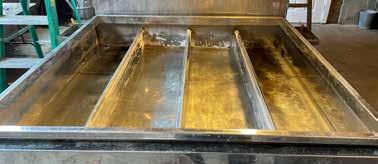
While Vermont may lack the stately Doric or ornate Corinthian columns that dominated Ancient Greek architecture, its aging barns are a testament to ingenuity—veritable temples of pragmatism. On-farm resourcefulness is a thing of beauty, and to the careful observer, old barns offer insight into the practical genius of generations.

An example of the type of simple innovations born out of need that abound on the farm can be found on the gable end of the Harwood Barn. There, just under the crown of the roof sits a heart-shaped hole that was carefully cut into the siding. At first glance it strikes the viewer as nothing more than a charming bit of ornamentation. However, in addition to adding a touch of character to the barn’s otherwise unadorned face, this often overlooked feature, called a Martin Hole, serves an important purpose. The hole provides easy access for predatory birds, such as small owls and (surprise) purple martins. Sited directly over the hay loft, the martin hole is a subtle, sustainable, and ecologically sound means of pest control that uses native predators to help manage rodent populations in the hay.
While the martin hole has served the same purpose since it was first cut out of the barn’s siding in the early 19th century, the Harwood Barn has been repurposed countless times since it was first built nearly 200 years ago. When it was raised, global demand for wool was high and “sheep fever” swept the Vermont hills. By the middle of the 1800s, two-thirds of the land that is now Merck Forest and Farmland Center had been cleared for pasture and nearly 1,000 sheep grazed the mountainsides. Around 1850, global markets shifted, and demand for Vermont wool declined precipitously. In response, hilltop farms diversified production to butter, cheese, and potatoes. In the Harwood Barn, lambs made way for calves and potatoes were stacked in crates in newly framed and vented root cellars. Over time, these systemic changes to farming in Vermont signaled the end to the hilltop farms as medium and later large-scale valley-based dairy farms began to dominate Vermont’s agricultural landscape.
It was around this time that George Merck purchased the three major properties that form what is now the heart of Merck Forest & Farmland Center: Masters Mountain, The Gallop, and lastly the Harwood Farm. Since this transition, the Harwood Barn has dutifully served MFFC in a variety of ways, including (but not providing space for educational programs and informational exhibits
The new releaser, mounted on top of the tank outside of the sap House, allows visitors to watch as slap flows in from the sugarbush.




Kits & Cubs
by Elena Santos, Education Coordinator
This winter, the Kits and Cubs group has learned about animal tracks, maple syrup, animals that live in trees, and snow, to name a few things. Activities have included making art on the ground with snow and nature objects found on the ground, playing in the snow kitchen, sitting quietly to listen for the sound of ravens, red squirrels and woodpeckers, tasting sap and maple syrup, finding nests in trees, following animal tracks in the snow, looking at logs up close that had been lived in by bugs, and using our imagination to pretend we are different plants and animals. The energy and curiosity that these little learners bring to the VC each week is invigorating and infectious and we love playing with them on the trails, in the woods, around the farm and in the Map Room!!




Introducing: Explorer’s Program

Introducing the Explorer’s Program! The Pathfinder Quest is the first installment in our two part Explorer’s Program. Designed for ages 5-12, the Pathfinder Quest will take participants on a hike around Merck Forest, following clues to hidden boxes. Each box has a stamp in it, artfully designed by our farm manager, Hadley Stock. When all of the stamps have been found and stamped into the book, participants can take the booklet to the Visitor Center to earn a sticker as a completion prize. The Pathfinder Quest is designed to be completed during one visit.

Save The Date
Farm Pasture Party
Merck Forest & Farmland Center staff will be opening our pastures to kick off the 2023 grazing season on Sunday, May 28

Come watch as we turn out our small flock of Romney sheep, our laying hens and our first group of meat birds.
Stroll up to the farm to share in the excitement as we kick off our 2023 grazing season. Throughout the day, forest and farm staff will be moving animals from interior, winter housing to summer pastures. Bring a picnic lunch, find a spot and share in the excitement of the day as the sheep take their first bite of fresh green grass, chicken tractors are populated, and the summer field season begins.
Merck Forest Farm staff will be on site to explain the process, answer questions and share in the excitement of the day. This is a self guided opportunity to experience one of our farm operations, rain or shine, no reservation needed.
Northern Woodlands: A New Way of Looking at the Forest

 By Chris Hubbard, Education Director
By Chris Hubbard, Education Director
Every few months a package arrives at the Visitor Center, heavy and packed full of Northern Woodlands magazines. We’re all eager for a copy, since the content is well written and informative to the work we do here at Merck Forest. The mission of the magazine, “advancing a culture of forest stewardship in the Northeast and increasing understanding of and appreciation for the natural wonders, economic productivity, and ecological integrity of the region’s forests” aligns with what we work on in our land management and our educational endeavors.
While focused on forest stewardship, the magazine’s featured articles and regular features cover a range of topics. Recreation, science, the labor market, history, and more are addressed. While written for adults, there are topics and illustrations that are engaging for people of all ages and interests to enjoy. Recent articles included such topics as creating climate-resilient forests, a visit with a luthier who creates guitars from recovered old growth “sink logs”, an interview with an ash basket weaver, and instructions on how to create casts of animal tracks.
Northern Woodlands’ regular features include, among other things, seasonal notes regarding animal and plant activity and phenology, book reviews, poetry, and an art review. If you live in or near forested lands, or have an interest in them, you’ll find a wealth of information in Northern Woodlands.


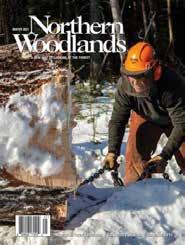
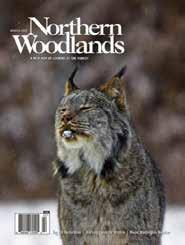

Northern Woodlands is published quarterly in Lyme, New Hampshire. Learn more about this marvelous resource at www.northernwoodlands.org.
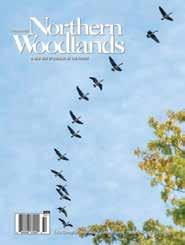
18
A tax-exempt, 501(C)(3) corporation in Vermont that has, for over 70 years, inspired curiosity, love and responsibiliy for natural and working lands through land stewardshipand conservation education.


 Hadley Stock, Farm Manager
Hadley Stock, Farm Manager
Springtime means two things at Merck Forest:
1: Chickens are in full egg-laying mode
2: Maple syrup production is in full swing
Put these two amazingly compatible ingredients together for a fast and delicious meal that is sure to excite!
Maple Poached Eggs
Ingredients:
1 cup maple syrup
2 large eggs
Buttered toast, for serving
1. In a small saucepan, bring the maple syrup to a boil over high heat. Reduce the heat to medium low and wait until the bubbles slow to a lazy simmer.
2. Gently crack the eggs into the syrup. Poach for 3 minutes, all the while spooning syrup over the tops of the eggs.
3. Using a slotted spatula, transfer each egg to a ramekin, cover with a small spoonful of syrup and serve immediately.

Maple Egg-in-a-Hole
Ingredients:

1 tablespoon of butter
1. Melt the butter in a non-stick frying pan over low heat.
2. Toast bagel halves in butter, crust side down, until golden.
3. Turn over half-bagels and break an egg in the center of each half.
4. Cook 2 to 3 minutes to desired firmness.
5. Pour maple syrup into pan and cook for 1 minute. Serve immediately, with fresh fruit on the side.
1 bagel, sliced
2 eggs


3 tablespoons of maple syrup (preferably amber syrup for its rich flavor)
Your choice of fresh fruit
20
Springtime
Complied
on the Mountain Recipes
By
Maple Egg Custard
Ingredients:
2½cups whole milk
4large eggs
¾cup maple syrup
1teaspoon vanilla extract
1. Preheat the oven to 325 degrees. In a medium saucepan, heat the milk over medium heat until very hot but not boiling. Meanwhile, in a large bowl, whisk the eggs with a fork, being careful to incorporate as little air as possible. Very gradually whisk in the hot milk. Whisk in the maple syrup and the vanilla. Strain the custard through a fine-mesh sieve and use a spoon to skim off the foam.
2. Place 6-cup ceramic ramekins or custard cups in a shallow roasting pan and pour in boiling water to reach halfway up their sides. Carefully ladle in the custard and bake until just set, about 40 minutes. Serve warm.
TECHNIQUE TIP: Making sure the butter in the tins is piping hot before you pour in the batter is the key to making sure they puff up perfectly.
SWAP OPTION: Can use honey instead of maple or just leave out if desired.
1. Preheat the oven to 425 F with an oven rack in the lower third of the oven. Spoon 2 teaspoons of melted butter into each cup of a 12-cup popover pan or large muffin pan. Place the pan in the oven to heat.
2. In a medium bowl, stir together flour and salt.
3. In a large bowl, whisk milk, maple syrup, eggs and remaining 2 tablespoons melted butter to combine. Gradually whisk the flour mixture into the egg mixture until almost smooth. Transfer the batter to a 4-cup spouted measuring cup.
4. Carefully remove the hot pan from the oven. Divide batter into popover cups, filling each two-thirds full. Bake until popovers are puffed and golden brown, 18 to 20 minutes. Once baked, lightly brush the tops with additional maple syrup. Remove hot popovers from the pan and serve immediately.
Maple Popovers
Ingredients:
½ cup plus 2 tablespoons unsalted butter, melted, divided
1 cup all-purpose flour

1 teaspoon kosher salt
3/4 cup whole milk, room temperature
1/4 Grade A Dark pure maple syrup, plus more for brushing
4 large eggs, room temperature


21
Upcoming Events


Please reserve your spot in one of our workshops by registering online at merckforest.org/shop/ Most of the listed activities have an outdoor component – all members of your party should be dressed appropriately for conditions, including water, snacks, sturdy footgear. Due to the low cost of our programs, refunds are not available unless an event is canceled by MFFC. Reservations are required for all events at merckforest.org. All events meet at the Visitor Center.
Kits & Cubs
Every Monday & Wednesday Morning 10:00am - 11:30pm
Preschool/toddler and parent meet-up group. Themed outdoor nature exploration, songs, story time, and take-home craft or project. No registration required, drop-ins welcome. We hope to see you up on the mountain!
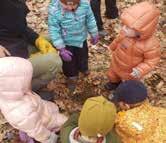

$5/person. No reservations required.
Meet & Feed
Every Sunday starting May 21 and every Thursday starting June 29 3:00pm - 4:30pm
Join Merck staff on Sunday afternoons as they go about afternoon chores feeding our animals. Get to know our sheep, horses, chickens, and pigs during our daily routine. Limited to 12 people. $5/person, space is limited, and reservations are required.



SOLO Wilderness First Aid Course
Saturday & Sunday, May 20 & 21 from 8:30am - 5:00pm
SOLO instructors will teach a 2-day Wilderness First Aid (WFA) course focusing on emergency backcountry skills, with the option of a CPR component. Certification for WFA is valid for 2 years. Recertification for SOLO Wilderness First Responder only is also possible through this course.
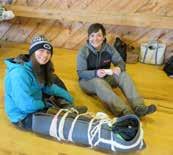


$210/person; CPR tuition is an additional $45/person. Preregistration is required.

Educational Farm Event Forest Event
merckforest.org 802-394-7836 SAVE THE DATE July 15, 2023 10:00am - 2:00pm Ecology Open House
Photographing Spring at Merck Forest

Saturday, May 20 from 10:00am - 4:00pm (Rain date: May 27)
Join Southern Vermont Art Center for photography workshops led by Thom Williams, a photographic artist. Ages 16 and up. $109 - $130, registration is through SVAC’s website, svac.org.
Photographing Summer at Merck Forest
Saturday, July 8 from 10:00am - 4:00pm (Rain Date: July 22)
Join Southern Vermont Art Center for photography workshops led by Thom Williams, a photographic artist. Ages 16 and up. $109 - $130, registration is through SVAC’s website, svac. org.

Summer Camps
All camps run Monday through Friday, from 9:00am - 3:00pm. Registration is required, and space is limited! $275/camper.
Trail Crew Camp for Grades 7 & 8: June 26 - 30
Field and Forest Camp for Grades 4 - 6: July 10 - 14
(FULL) Farm Camp for Grades 1 - 3: July 10 - 14
(FULL) Field and Forest Camp for Grades 1 - 3: July 17 - 21
Field and Forest Camp for Grades 4 - 6: July 17 - 21
(FULL) Field and Forest Camp for Grades 1 - 3: July 24 - 28
Field and Forest Camp for Grades 4 - 6: July 24 - 28
(FULL) Field and Forest Camp for Grades 1 - 3: July 31 - August 4



Farm Camp for Grades 4 - 6: July 31 - August 4

Farm Crew Camp for Grades 7 & 8: Aug. 7 - 11
Game of Logging


(FULL) Women’s Basic Use and Safety Chainsaw course - Saturday, May 6, 8:00am - 4:00pm. $220, preregistration is required.
(FULL) Co-ed Basic Use and Safety chainsaw course - Sunday, May 7, 8:00am - 4:00pm. $220, preregistration is required.
Women’s Game of Logging Levels 1 & 2 chainsaw course - Saturday & Sunday, May 13 & 14, 8:00am - 4:00pm. $440, registration is required. Space is still available!
(FULL) Co-ed Game of Logging Level 1 & 2 chainsaw course - Saturday & Sunday, May 20 & 21, 8:00am - 4:00pm. $440, registration is required.
Game of Logging Levels 3 (FULL) & 4 chainsaw course- Saturday & Sunday, June 3 & 4, 8:00am - 4:00pm. $440, registration is required.



3270 Route 315
PO Box 87
PRESORTED STD US POSTAGE PAID MANCHESTER, VT 05254 PERMIT No. 3
Rupert, VT 05768
Merck Forest & Farmland Center is on a mission to inspire curiosity, love and responsibility for natural and working lands.






























 by Cara Davenport, Education Manager
by Cara Davenport, Education Manager



 by Rob Terry, Exective Director
by Rob Terry, Exective Director















 By Chris Hubbard, Education Director
By Chris Hubbard, Education Director








 Hadley Stock, Farm Manager
Hadley Stock, Farm Manager

















